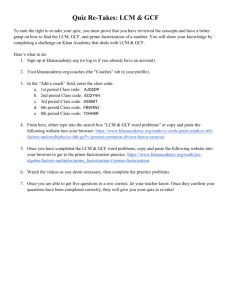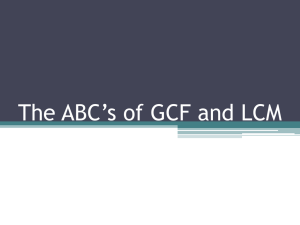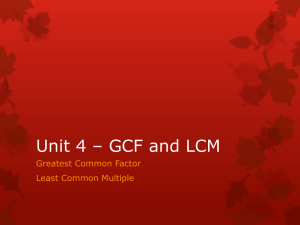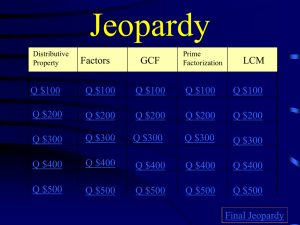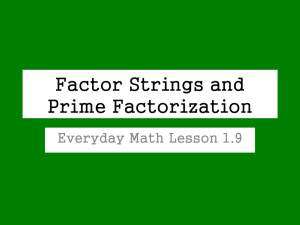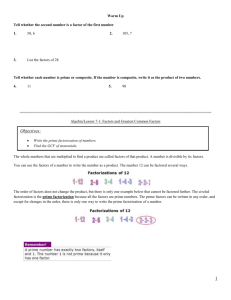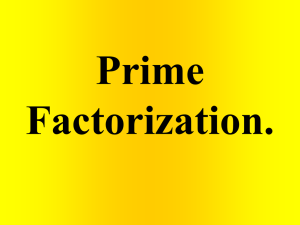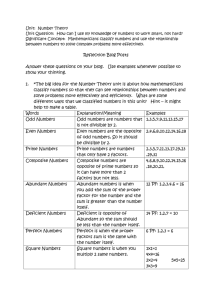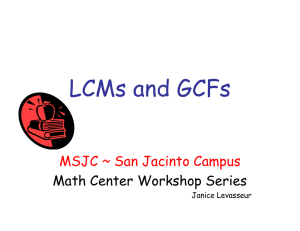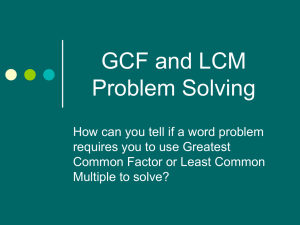GCF and LCM - SchoolNotes
advertisement
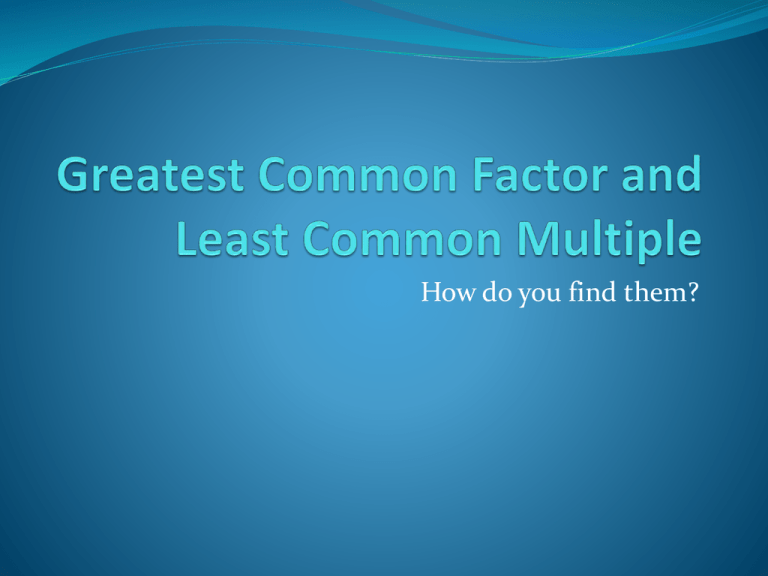
How do you find them? At the beginning of the summer, Lauren had a balance $25 in her bank account. She saved a total of $145 from her summer job, which she deposited into her account. Today Lauren withdrew enough money from her account to cover her $20 athletic facilities fee and her $30 uniform fee. If Lauren made no other withdrawals or deposits, what is her account balance? The balance of Lauren’s account is $120. Starting today, Lauren will earn $20 each week in allowance, which she plans to deposit into her bank account. If Lauren makes no other withdrawals or deposits, after how many weeks will the balance in her bank account be double what it is now? Her account will double in 6 weeks. Warm-Up 1. What is the prime factorization of 48? Prime Factorization of 24: 2•2•2•23 2. What is the GCF of 35, 21, and 84? The GCF of 35, 21, and 84 is 7. Warm-Up 1. Find the GCF of 28 and 42 using prime factorization. 28 = 2 2 7 and 42 = 2 3 7 The GCF of 28 and 42 is 14. 1. What is the LCM of 12 and 32? The LCM of 12 and 32 is 96. What is a factor? 2 and 3 are both factors of 6. What are the other factors of 6? What is a prime number? Numbers that have no other factors but itself and one! What are the first 6 prime numbers? 2, 3, 5, 7, 11, 13 What is prime factorization? The prime numbers that multiply together to get the original number. Use the ladder method! Begin with the lowest prime number and see if it is divisible by the original number. 2. Continue until it is no longer divisible by that number, then move on to the next prime number 3. Continue dividing by prime numbers until the only number left inside the ladder is one 1. What is the prime factorization of 24? 2 24 2 12 2 6 3 3 Prime Factorization of 24: 2•2•2•3 1 What is the prime factorization of 39? 3 39 13 13 1 Prime Factorization of 39: 3•13 What is the Greatest Common Factor? It is the largest of the common factors between two numbers. Method 1: Rainbow! What is the greatest common factor of 16 and 36? 16: 1, 2, 4, 8, 16 36: 1, 2, 3, 4, 6, 9, 12, 18, 36 The greatest common factor or 16 and 36 is 4. List all the factors of each of the numbers. Once you either have 2 of the same factors or numbers that are so close there are no other factors between them, then you’ve reached the middle of the rainbow. Method 2: Find each number’s prime factorization What is the greatest common factor of 12 and 18? 2 18 3 9 What do 3 3 they have in 1 common? 2 12 2 6 33 1 2•2•3 2•3=6 2•3•3 The greatest common factor of 12 and 18 is 6. What is the greatest common factor of 28 and 35? Use both methods 28: 1, 2, 4, 7, 14, 28 35: 1, 5, 7, 35 2 28 2 14 77 1 2•2•7 Using the rainbow method, the GCF is 7. 5 35 7 7 1 5•7 Using the prime factorization method, the GCF is 7. Warm-Up What is a multiple? The number you get when you multiply a number by another number What are the multiples of 5? 5, 10, 15, 20, 25, 30… What is the least common multiple? It is the smallest multiple that is shared between two numbers. How to find LCM It’s simple…Just list the multiples of each number until you find one that is in common! What is the LCM of 4 and 7? 4: 4, 8, 12, 16, 20, 24, 28 7: 7, 14, 21, 28 What is the LCM of 12 and 16? 12: 12, 24, 36, 48 16: 16, 32, 48 Which should you use to solve the problem, GCF or LCM? Two shuttles leave the Hard Rock Hotel to go to Universal Studios at the same time. The Minion Madness shuttle returns to the hotel every 8 minutes. The Incredible Hulk shuttle returns to the hotel every 10 minutes. In how many minutes will Minion Madness and the Incredible Hulk leave the hotel together for the second time? Use the LCM! The shuttles will leave the hotel at the same time in 40 minutes. Which should you use to solve the problem, GCF or LCM? Mr. Schuester directs two show choirs. One choir has 28 students. The other choir has 36 students. For rehearsals, he wants to divide each chorus into the largest possible equal groups with no students left over. How many students will be in each group? Use the GCF! Mr. Schuester can divide each choir into groups of 4. Warm-Up Let’s have Tim and Moby gives us the basics. :) http://www.brainpop.com/math/numbersandoperations/distri butiveproperty/ How does the distributive property work? The number outside the parentheses “jumps” over the parentheses and multiplies by each number inside! Just bring down the sign! Multiply and then add! 2(2 + 3) (2 • 2) + (2 • 3) (4) + (6) =10 You can write a number or sum in distributive form… How can you write an expression equal to 33 + 77 using distributive form? 1. Find the GCF of the two numbers. (This will go outside of the parentheses.) GCF: 11 11() 2. Now use the other factor that multiplies with the GCF to get the original number. (Those 2 numbers go inside of the parentheses.) 3 • 11 & 7 • 11 11(3 + 7) Now you try one! The number 108 can be expressed as the sum 100 + 8. How can you use the distributive property to rewrite that sum as a multiple of a sum whose addends have no common factors? (Tip: Ignore all the crazy wording and just figure out what’s important!) 4(25 + 2)
